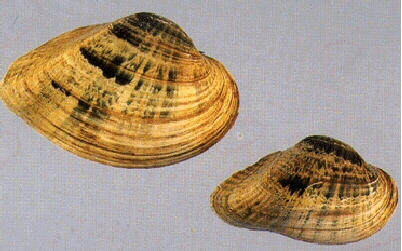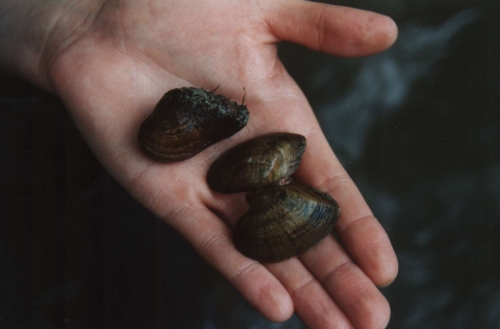Plants and Animals
Epioblasma triquetra Snuffbox
Key Characteristics
The snuffbox is a medium sized (to 2 inches) mussel that is triangular in shape. Its shell is thick and yellowish on the outside with numerous, broken, dark green rays. Beak sculpture is double looped and the hinge teeth are elevated and compressed.
Status and Rank
US Status: LE - Listed Endangered
State Status: E - Endangered (legally protected)
Global Rank: G2G3 - Rank is uncertain, ranging from imperiled to vulnerable
State Rank: S1S2 - Rank is uncertain, ranging from critically imperiled to imperiled
Occurrences
| County | Number of Occurrences | Year Last Observed |
|---|---|---|
| Allegan | 1 | 1996 |
| Berrien | 3 | 2001 |
| Calhoun | 1 | 2019 |
| Clinton | 2 | 2020 |
| Gladwin | 1 | 2021 |
| Gratiot | 1 | 2001 |
| Huron | 2 | 1964 |
| Ionia | 14 | 2021 |
| Kalamazoo | 2 | 2020 |
| Kent | 7 | 2022 |
| Livingston | 8 | 2023 |
| Macomb | 7 | 2017 |
| Midland | 4 | 2020 |
| Monroe | 5 | 1981 |
| Muskegon | 1 | 2018 |
| Newaygo | 1 | 2002 |
| Oakland | 7 | 2021 |
| Saginaw | 3 | 1965 |
| St. Clair | 15 | 2021 |
| St. Joseph | 7 | 2005 |
| Tuscola | 1 | 1940 |
| Washtenaw | 4 | 2021 |
| Wayne | 7 | 2019 |
Information is summarized from MNFI's database of rare species and community occurrences. Data may not reflect true distribution since much of the state has not been thoroughly surveyed.
Habitat
The snuffbox inhabits sand, gravel, or cobble substrates in swift small and medium-sized rivers. Individuals are often buried deep in the sediment.
Specific Habitat Needs
Gravel substrate needed in: Mainstem stream (3rd-4th order), riffle; River (5th-6th order), riffle.
Natural Community Types
- Mainstem stream (3rd-4th order), riffle
- River (5th-6th order), riffle
For each species, lists of natural communities were derived from review of the nearly 6,500 element occurrences in the MNFI database, in addition to herbarium label data for some taxa. In most cases, at least one specimen record exists for each listed natural community. For certain taxa, especially poorly collected or extirpated species of prairie and savanna habitats, natural community lists were derived from inferences from collection sites and habitat preferences in immediately adjacent states (particularly Indiana and Illinois). Natural communities are not listed for those species documented only from altered or ruderal habitats in Michigan, especially for taxa that occur in a variety of habitats outside of the state.
Natural communities are not listed in order of frequency of occurrence, but are rather derived from the full set of natural communities, organized by Ecological Group. In many cases, the general habitat descriptions should provide greater clarity and direction to the surveyor. In future versions of the Rare Species Explorer, we hope to incorporate natural community fidelity ranks for each taxon.
Management Recommendations
The Snuffbox mussel is sensitive to river impoundment, siltation and disturbance, due to its requirement for clean, swift current and relative immobility as an adult. In order to maintain the current populations in Michigan, rivers need to be protected to reduce silt loading and run-off. Maintaining or establishing vegetated riparian buffers can aid in controlling many of the threats to mussels. Control of zebra mussels is critical to preserving native mussels. And as with all mussels, protection of their hosts habitat is also crucial. Because the life cycle of the snuffbox is inherently linked with that of the logperch in Michigan, conservation and management of this fish species is needed to insure that of the Snuffbox.
Survey Methods
Glass-bottom bucket less than waist deep water
Survey Period: From first week of June to first week of October
SCUBA searches
Survey Period: From first week of June to first week of October
Snorkeling searches
Survey Period: From first week of June to first week of October
References
Survey References
- Cummings, K.S. and C.A. Mayer. 1992. Field Guide to Freshwater Mussels of the Midwest. Illinois Natural History Survey Manual 5, Champaign. 194pp.
- Strayer, D.L. and D.R. Smith. 2003. A Guide to Sampling Freshwater Mussel Populations. American Fisheries Society Monograph 8, Bethesda. 103pp.
Technical References
- Burch, J.B. 1994. Mollusk: Species Accounts. Pages 395-410 in D.C. Evers, ed. Endangered and Threatened Wildlife of Michigan. University of Michigan Press, Ann Arbor.
- Carman, S.M. and R.R. Goforth. 2000. Special animal abstract for Epioblasma triquetra (Snuffbox). Michigan Natural Features Inventory, Lansing, MI. 2pp.
- Cummings, K.S. and C.A. Mayer. 1992. Field Guide to Freshwater Mussels of the Midwest. Illinois Natural History Survey Manual 5, Champaign. 194pp.
- Dillon, R.T. Jr. 2000. The Ecology of Freshwater Molluscs. Cambridge University Press, Cambridge, UK. 509pp.
- Evers, D.C. 1994. Endangered and Threatened Wildlife of Michigan. The University of Michigan Press, Ann Arbor. 412pp.
- Watters, G.T. 1993. A guide to the freshwater mussels of Ohio. Revised Edition. The Ohio Department of Natural Resources, Columbus. 106 pages.



